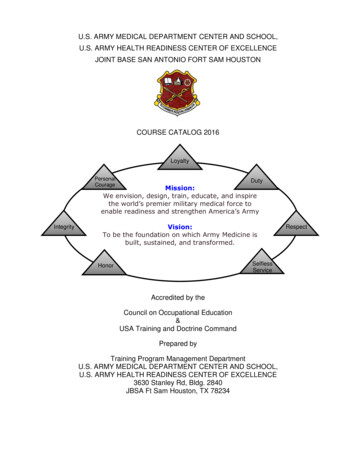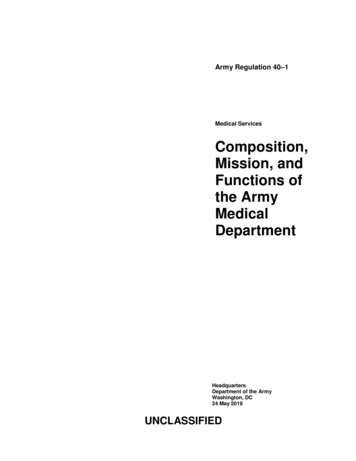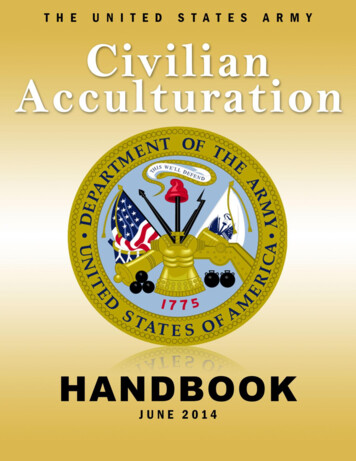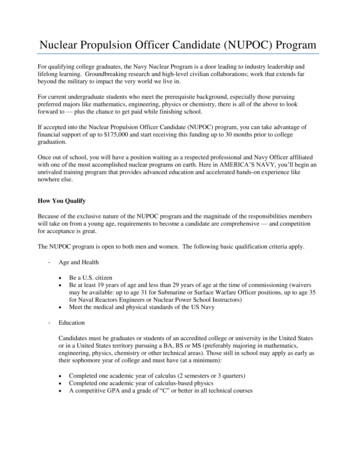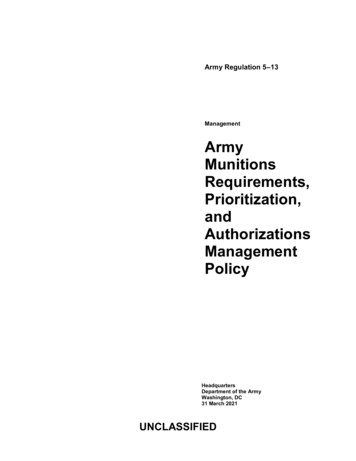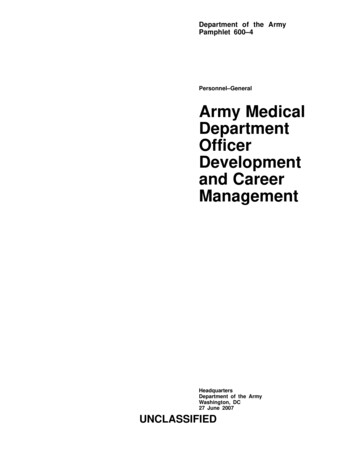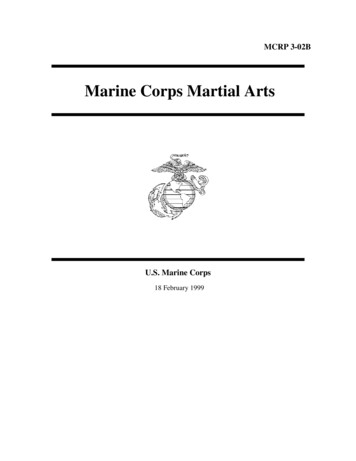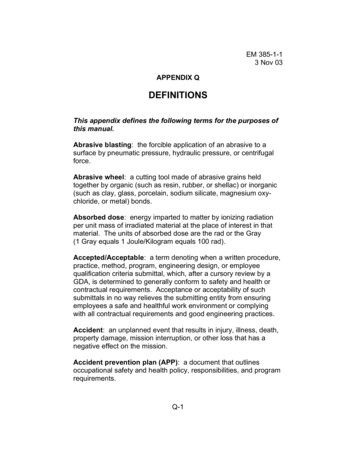
Transcription
EM 385-1-13 Nov 03APPENDIX QDEFINITIONSThis appendix defines the following terms for the purposes ofthis manual.Abrasive blasting: the forcible application of an abrasive to asurface by pneumatic pressure, hydraulic pressure, or centrifugalforce.Abrasive wheel: a cutting tool made of abrasive grains heldtogether by organic (such as resin, rubber, or shellac) or inorganic(such as clay, glass, porcelain, sodium silicate, magnesium oxychloride, or metal) bonds.Absorbed dose: energy imparted to matter by ionizing radiationper unit mass of irradiated material at the place of interest in thatmaterial. The units of absorbed dose are the rad or the Gray(1 Gray equals 1 Joule/Kilogram equals 100 rad).Accepted/Acceptable: a term denoting when a written procedure,practice, method, program, engineering design, or employeequalification criteria submittal, which, after a cursory review by aGDA, is determined to generally conform to safety and health orcontractual requirements. Acceptance or acceptability of suchsubmittals in no way relieves the submitting entity from ensuringemployees a safe and healthful work environment or complyingwith all contractual requirements and good engineering practices.Accident: an unplanned event that results in injury, illness, death,property damage, mission interruption, or other loss that has anegative effect on the mission.Accident prevention plan (APP): a document that outlinesoccupational safety and health policy, responsibilities, and programrequirements.Q-1
EM 385-1-13 Nov 03Accident, recordable: any accident meeting the definition of anArmy accident that involves a Government employee, Contractor,or member of the public that rises to the severity level that they areused to calculate accident experience rates.Accident, reportable: all USACE and Contractor accidentsincluding occupational illnesses, injuries, and property damage.Accredited testing laboratory: a laboratory that an accreditingorganization has determined has demonstrated the ability toconduct air quality testing according to their standard.Activity hazard analysis (AHA): a documented process by whichthe steps (procedures) required to accomplish a work activity areoutlined, the actual or potential hazards of each step are identified,and measures for the elimination or control of those hazards aredeveloped.Aerial lift: include the following vehicle-mounted aerial devicesused to elevate personnel to job sites above the ground: aerialladder, extensible boom platform, articulating boom platform,vertical tower, and a combination of these devices.Affected employee: a person whose position requires him/her tooperate or use a system that is under lockout or tagout or whoseposition requires him/her to work in an area where a system that isunder lockout or tagout is being serviced or maintained.Air-purifying respirator: a respirator with an air-purifying filter,cartridge, or canister that removes specific air contaminants bypassing ambient air through the air-purifying element.Air receiver: a tank used for the storage of air discharged from thecompressor; used to help eliminate pressure pulsations in thedischarge line.All-terrain vehicle (ATV), Class I: a motorized off-highwayvehicle, 50 in (127 cm) or less in width, having dry weight of 800 lbs(362.9 kg) or less, and traveling on three or more low pressure tiresQ-2
EM 385-1-13 Nov 03(10 lbs (4.5 kg) psi or less), with a seat designed to be straddled bythe operator.All-terrain vehicle (ATV), Class I, Category G: an ATV intendedfor general recreational and utility use.All-terrain vehicle (ATV), Class I, Category U: an ATV intendedprimarily for utility use.All-terrain vehicle (ATV), Class II: a motorized off-highwayvehicle with a width which exceeds 50 in (127 cm) or having a dryweight that exceeds 800 lbs (362.9 kg), traveling on four or morelow-profile, low-pressure tires (10 lbs (4.5 kg) psi or less) andhaving a bench seat.Aloft: at a height of 6 ft (1.8 m) or more above the ground.Altered: any change to the original manufacturer’s designconfiguration. These are:a. Replacement of weight-handling equipment parts andcomponents with parts or components not identical with theoriginal (i.e., change in material, dimensions, or designconfiguration);b. The addition of parts or components not previously a part ofthe equipment;c. The removal of components that were previously a part ofthe load handling equipment; andd. Rearrangement of original parts or components.Anchor handling barge: a floating work platform consisting of apontoon or barge, hoisting equipment, and a fixed A-frame thatcannot slew or change radius. An anchor barge is used to extractanchors or buoy weights imbedded in the earth. The load is oftenunknown and is often not under the tip of the A-frame.Q-3
EM 385-1-13 Nov 03Anchorage: a secure point of attachment for lifelines, lanyards,deceleration devices, or tiebacks.Anchored bridging: the steel joist bridging is connected to abridging terminus point.Anti-runaway: a safety device to stop a declining conveyor in caseof mechanical or electrical failure.Anti-two blocking (A2B) (upper limit) device: a device that isactivated by two-blocking and disengages the particular functionwhose movement is caused by the two-blocking.Approach-departure clearance surface: an extension of theprimary surface and the clear zone at each end of the runway, firstalong an inclined plane (glide angle) and then along a horizontalplane, both flaring symmetrically about the runway centerlineextended.Approach-departure clearance zone: the ground area under theapproach-departure clearance surface.Apron conveyor: a conveyor in which a series of apron pansforms a moving bed.Apron pans: one of a series of overlapping or interlocking platesor shapes that, together with others, form the conveyor bed.Approved: a method, equipment, procedure, practice, tool, etc.,that is sanctioned, confirmed, as acceptable for a particular use orpurpose by a person or organization authorized to render suchapproval or judgment.Arc: a controlled electrical discharge between the electrode andthe work piece that is formed and sustained by a gas that has beenheated to such a temperature that it can conduct electric current.Q-4
EM 385-1-13 Nov 03Arc cutting: a thermal cutting process that severs or removesmetal by melting with the heat of an arc between an electrode andthe work piece.Arc welding: a welding process that joins work pieces by heatingthem with an arc.Articulating boom crane: a crane with a boom that has sectionsthat are articulated by hydraulic cylinders. The boom may have atelescoping section. The crane can be stationary or mounted on avehicle, track, locomotive, etc., and is used to lift, swing, and lowerloads.Assigned protection factor (APF): the minimum anticipatedprotection provided by a properly functioning respirator or class ofrespirators to a given percentage of properly fitted and trainedusers.Associate Safety Professional (ASP): an individual who iscurrently certified by the Board of Certified Safety Professionals(BCSP).Atmosphere-supplying respirator: a respirator that supplies therespirator user with breathing air from a source independent of theambient atmosphere, and includes SARs and SCBA units.Attendant (confined space): an individual stationed outside oneor more permit spaces who monitors the authorized entrants andwho performs all attendant’s duties assigned in the employer’spermit space program.Authorized employee: a qualified person who is designated, inwriting by the designated authority, to request, receive, implement,and remove energy control procedures.Authorized entrant (confined space): an employee who isauthorized by the employer to enter a permit space.Q-5
EM 385-1-13 Nov 03Automatic circuit re-closer: a self-controlled device forautomatically interrupting and re-closing an alternate current circuitwith a predetermined sequence of opening and re-closing followedby resetting, hold closed, or lockout operation.Automatic fire detection device: a device designed toautomatically detect the presence of fire by heat, flame, light,smoke, or other products of combustion.Automatic trap: a device for removing moisture from compressedgas systems.Back cut: the final cut in a felling operation, made horizontally onthe opposite side from the undercut. See definition of notch.Backstop: a device to prevent reversal of a loaded conveyorunder action of gravity when forward travel is interrupted.Barricade: a physical obstruction, such as tape, screens, orcones, intended to warn of and limit access to a hazardous area.Barrier: a physical obstruction that is intended to prevent contactwith energized lines or equipment.Beam platform: a work platform made up of wood beams(oriented vertically).Bearer: a horizontal member of a scaffold upon which the platformrests and that may be supported by runners.Bell: an enclosed compartment, pressurized (closed bell) or unpressurized (open bell), which allows the diver to be transported toand from the underwater work area and which may be used as atemporary refuge during diving operations.Benching: a method of protecting employees from cave-ins bycutting the sides of the excavation in the arrangement of one orQ-6
EM 385-1-13 Nov 03more horizontal levels, usually with vertical or near-vertical wallsbetween steps.Bending moment: the overturning effect at a point which is theproduct of a force and the distance from the point from which theforce is applied.Blast area: the area in which explosive loading and blastingactivities are being conducted and the area immediately adjacentthat is within the influence of fly-rock and concussion.Blast site: the area in which explosive materials are being loaded,or have been loaded, including all holes to be loaded for the sameblast for a distance of 50 ft (15.2 m) on all sides.Blaster: the person(s) authorized to use explosives for blastingpurposes.Blasting agent: any material or mixture, consisting of a fuel andoxidizer, intended for blasting, not otherwise classified as anexplosive, and in which none of the ingredients is classified as anexplosive, provided that the finished product, as mixed andpackaged for use or shipment, cannot be detonated by means of aNo. 8 blasting cap when unconfined.Blasting machine: a device used to supply initiation current toblasting circuits.Boatswain’s chair: a suspended seat designed to accommodateone worker.Boatswain’s stand: a suspended stand designed toaccommodate one worker in a standing position.Body belt: a strap with means for securing about the waist and isused for positioning, restraint, or ladder climbing only. Body beltsmay not be used for fall arrest.Q-7
EM 385-1-13 Nov 03Body harness, full: straps that are secured about a body in amanner that distributes the arresting forces over at least the thighs,waist, chest, shoulders, and pelvis, with provision for attaching alanyard, lifeline, or deceleration device.Bolted diagonal bridging: diagonal bridging that is bolted to asteel joist or joists.Bond: an electrical connection from one conductive element toanother to minimize potential differences or providing suitableconductivity for fault current or for mitigation of leakage current andelectrolytic action.Bonding: the permanent joining of metallic parts to form anelectrically conductive path that will ensure electrical continuity andcapacity to conduct safely any current likely to be imposed.Bonding jumper: a reliable conductor to ensure the requiredelectrical conductivity between metal parts required to beelectrically connected.Boom: a member hinged to the superstructure or a crane/derrickand used for supporting hoisting tackle.Boom-angle: the angle above or below the horizontal of thelongitudinal axis of the base of the boom section.Boom-angle indicator: a device that measures the angle of theboom to the horizontal.Boom hoist mechanism: means for supporting the boom andcontrolling boom angle.Boom, live: a boom in which lowering (free-fall) is controlled by abrake without aid from other lowering retarding devices.Boom stop (crane): a device used to limit the angle of the boomat the highest position.Q-8
EM 385-1-13 Nov 03Bottom time: the total elapsed time, measured in minutes, fromthe time when the diver leaves the surface in descent to the timethat the diver begins ascent.Braided sling: a sling made from braided rope.Branch circuit: the circuit conductors between the final overcurrent device protecting the circuit and the outlet(s).Brazing: a welding process that joins materials by heating them toa temperature that will not melt them but will melt a filler materialwhich adheres to them and forms a joint.Bricklayers’ square scaffold: a scaffold made up of a workplatform (planking) supported on bricklayers’ squares.Bridge: that part of a gantry or overhead crane that carries thetrolley(s).Bridging clip: a device that is attached to the steel joist to allowthe bolting of the bridging to the steel joist.Bridging terminus point: a wall, a beam, tandem joists (with allbridging installed and a horizontal truss in the plane of the topchord) or other element at an end or intermediate point(s) of a lineof bridging that provides an anchor point for the steel joist bridging.Bridle sling: multiple-leg-sling; the legs of the sling are spread todistribute the load.Bucket conveyor: any type of conveyor in which the material iscarried in a series of buckets.Bucking: the act of sawing a felled tree or limbs into smallersections.Q-9
EM 385-1-13 Nov 03Bus wire: an expendable wire used in parallel or series-in-parallelcircuits to which are connected the leg wires of electric blastingcaps.Bushing: an insulating device or lining used to protect a conductorwhere it passes through an aperture.Cable: a conductor with insulation, or a stranded conductor with orwithout insulation and other coverings (single-conductor cable), or acombination of conductors insulated from one another (multipleconductor cable).Cable laid endless sling: mechanical joint: a wire rope slingmade from one continuous length of cable laid rope with the endsjoined by one or more metallic fittings.Cable laid grommet, hand tucked: an endless wire rope slingmade from one continuous length of rope formed to make a bodycomposed of six ropes around a rope core. The rope ends aretucked into the body, forming the core. No sleeves are used.Cable laid rope: a rope composed of several wire ropes laid asstrands around a wire rope core.Cable laid rope sling, mechanical joint: a wire rope sling madefrom a cable laid wire rope with eyes fabricated by pressing orswaging metal sleeves over the rope junction.Cable sheath: a protective covering applied to cables.Caisson: a watertight chamber (of wood or steel sheeting or aconcrete or steel cylinder) used in construction work underwater oras a foundation. When the bottom of the structure extends belowthe surface of free water, excavation is performed by workers in aworking chamber at an air pressure greater than atmosphericpressure.Calyx hole: a hole, typically 30 in (76.2 cm) in diameter or larger,drilled into the earth primarily for subsurface exploration.Q-10
EM 385-1-13 Nov 03Canister or cartridge: a container with a filter, sorbent, or catalyst,or combination of these items, which removes specificcontaminants from the air passed through the container.Capstan: a spool-shaped revolving drum, manually or poweroperated, used for heaving in of heavy mooring lines.Car-arresting device: a device that will stop and hold the car withits rated load in the event of the failure of the wire rope, rack, pinionor other car suspension means.Carbon dioxide (CO2): a colorless, odorless, electricallynonconductive inert gas which acts as an extinguishing medium byreducing the concentration of oxygen or fuel vapor in the air to thepoint where combustion is impossible.Carpenter’s bracket scaffold: a scaffold made up of a workplatform supported on wood or metal brackets.Catch platform: a temporary structure erected around, attached toand abutting the building being demolished for the purpose ofsafeguarding and protecting the employees and the public bycatching and retaining falling objects or debris.Cathead: a spool shaped attachment on a winch around whichrope is wound for hoisting and pulling.Certified Construction Heath and Safety Technician (CHST):an individual who is currently certified by the BSCP.Certified Health Physicist (CHP): an individual who is currentlycertified by the American Board of Health Physics.Certified Industrial Hygienist (CIH): an individual who is currentlycertified by the American Board of Industrial Hygiene.Certified Safety Professional (CSP): an individual who iscurrently certified by the BCSP.Q-11
EM 385-1-13 Nov 03Certified Safety Trained Supervisor (CSTS): an individual who iscurrently certified by the BCSP.Chain conveyor: any type of conveyor in which one or morechains act as the conveying medium.Choker: a sling used to form a slip noose around an object.Christmas tree lifting: the tandem lifting of steel (multiple steelmembers rigged together) by one crane.Chute: a trough or tube used to guide and transport slidingobjects, materials or debris from a higher to a lower level.Circuit: a conductor or system of conductors through which anelectric current is intended to flow.Circuit breaker: a device designed to open and close a circuit bynon-automatic means and to open and close a circuit automaticallyon a predetermined overcurrent without damage to itself whenproperly applied within its rating.Class A fire: a fire involving ordinary combustible materials suchas wood, paper, clothing, and some rubber and plastic materials.Class B fire: a fire involving flammable or combustible liquids,flammable gases, greases and similar materials, and some rubberand plastic materials.Class C fire: a fire involving energized electrical equipmentwhere safety to the employee requires the use of electricallynonconductive extinguishing media.Class D fire: a fire involving combustible metals such asmagnesium, zirconium, sodium, and potassium.Q-12
EM 385-1-13 Nov 03Cleanout: a hole that is put in the concrete masonry unit block toverify that grout goes all the way to the bottom of the cell of blocksin a wall (filling the void cells). The cleanout being in this positionkeeps employees from under the scaffolding where they arepumping the grout in overhead.Cleat: a mooring fitting having two horizontal arms to whichmooring lines are secured.Coarse laid rope: 6 x 7 wire rope (6 strands, 7 wires per strand).Cofferdam: a temporary structure used to keep water (and earth)out of an excavation during construction of the permanent structure.Cold forming: the process of using press brakes, rolls, or othermethods to shape steel into desired cross sections at roomtemperature.Column: a load-carrying vertical member that is part of the primaryskeletal framing system. Columns do not include posts.Combustible liquid: a liquid having a flash point at or above100 F (38 C). Combustible liquids are subdivided as follows:a. Class II liquids have flash points at or above 100 F (38 C)and below 140 F (60 C).b. Class IIIA liquids have flash points at or above 140 F(60 C) and below 200 F (93 C).c. Class IIIB liquids have flash points at or above 200 F(93 C).Command: the USACE Major Subordinate Command, District,Laboratory, or Field Operating Activity with responsibility for aparticular activity.Q-13
EM 385-1-13 Nov 03Committed dose equivalent: The dose equivalent to organs ortissues of reference that will be received from an intake ofradioactive material by a person during the 50-year period followingthe intake.Committed effective dose equivalent: the sum of the products ofthe weighting factors applicable to each of the body organs ortissues irradiated and the committed dose equivalent to theseorgans or tissues.Competent person: one who can identify existing and predictablehazards in the working environment or working conditions that aredangerous to personnel and who has authorization to take promptcorrective measures to eliminate them.Competent person for confined space: A person meeting thecompetent person requirements defined in Section 1 who isassigned in writing by the GDA to assess confined spaces, toinclude ship and vessel repair and maintenance at USACEfacilities, and who possesses demonstrated knowledge, skill, andability to:a. Identify the structure, location, and designation of confinedand PRCS where work is done;b. Calibrate and use testing equipment including, but not limitedto, oxygen indicators, combustible gas indicators, CO indicators,and CO2 indicators, and to interpret accurately the test results ofthat equipment;c. Perform all required tests and inspections specified in29 CFR 1910.146 and 29 CFR 1915, Subpart B;d. Assess hazardous conditions including atmospheric hazardsin confined space and adjacent spaces and specify thenecessary protection and precautions to be taken;e. Determine ventilation requirements for confined spaceentries and operations,Q-14
EM 385-1-13 Nov 03f. Assess hazards associated with hot work in confined andadjacent space and determine fire watch requirements; andg. Maintain records required.Conductor: a material, usually in the form of a wire, cable, or busbar, suitable for carrying an electric current.Conductor shielding: an envelope that encloses the conductor ofa cable and provides an equipotential surface in contact with thecable insulation.Confined space: a space that:a. Is large enough and so configured that a person can bodilyenter and perform assigned work; andb. Has limited or restricted means for entry or exit such that theentrant’s ability to escape in an emergency would be hindered(e.g., tanks, vessels, silos, storage bins, hoppers, vaults, andpits are spaces that may have limited means of entry; doorwaysare not considered a limited means of entry or egress); andc. Is not designed for continuous worker occupancy.Connector: an employee who, working with hoisting equipment, isplacing and connecting structural members and/or components.Constructibility: the ability to erect structural steel members inaccordance with 29 CFR 1926, Subpart R, without having to alterthe over-all structural design.Construction load: (for joist erection) means any load other thanthe weight of the employee(s), the joists and the bridging bundleContainer: any vessel of 60 gal (0.23 m3) or less capacity used fortransporting or storing liquids.Q-15
EM 385-1-13 Nov 03Contaminant: any material, that, by nature of its composition orreaction with other materials, is potentially capable of causinginjury, death, illness, damage, loss, or pain.Contractor: any individual or firm under contractual agreementwith the government or its subunits for the performance of servicesand products, such as construction, maintenance, and hazardouswaste activities, including subcontractors of a prime contractor.Controlled decking zone (CDZ): an area in which certain work(e.g., initial installation and placement of metal decking) may takeplace without the use of guardrail systems, personal fall arrestsystems, fall restraint systems, or safety net systems and whereaccess to the zone is controlled.Controlled load-lowering: lowering a load by means of amechanical hoist drum device that allows a hoisted load to belowered with maximum control using the gear train or hydrauliccomponents of the hoist mechanism. Controlled load loweringrequires the use of the hoist drive motor, rather than the load hoistbrake, to lower the load.Conveyor: a horizontal, inclined, or vertical device for transportingmaterial in a path predetermined by the design of the device andhaving points of loading and discharge.Conveyor, flight: a type of conveyor consisting of one or moreendless propelling media, such as chain, to which flights areattached, and a trough through which material is pushed by theflights.Conveyor, portable: a transportable conveyor that is not selfpropelled, usually having supports that provide mobility.Conveyor, screw: a conveyor screw revolving in a suitablyshaped stationary trough or casing fitted with hangers, trough ends,and other auxiliary accessories.Q-16
EM 385-1-13 Nov 03Corrosive: is a substance that can cause destruction of livingtissue or damage by chemical action, including acids with a pH of2.5 or below or caustics with a pH of 11.0 or above.Crane: a machine for lifting or lowering a load and moving ithorizontally, with the hoisting mechanism being an integral part ofthe machine.Crane, commercial truck mounted: a crane consisting of arotating superstructure (center post or turn table), boom, operatingmachinery, and one or more operator’s stations mounted on aframe attached to a commercial truck chassis, usually retaining apayload hauling capability whose power source usually powers thecrane.Crane, crawler: a crane consisting of rotating superstructure witha power plant, operating machinery, and a boom, mounted on abase and equipped with crawler treads for travel.Crane, floating: a rotating superstructure, power plant, operatingmachinery, and boom, mounted on a barge or pontoon. The powerplant may be installed below decks. The crane’s function is tohandle loads at various radii.Crane, floor operated: a crane that is pendant or nonconductiverope controlled by an operator on the floor or an independentplatformCrane, gantry: a crane similar to an overhead crane except thatthe bridge is rigidly supported on two or more legs running on fixedrails or other runway.Crane, hammerhead: a lifting machine arranged with a tower(mast), an upper structure that rotates, a horizontally-extended loadjib (boom) with trolley, and a counterweight jib extending in thedirection opposite of the load jib: neither jib are arranged for luffing.Q-17
EM 385-1-13 Nov 03The trolley on the load jib traverses the length of the jib andcontains the sheaves and accessory parts which make up theupper load block; the lower load block is suspended from thetrolley.Crane, locomotive: a crane mounted on a base or car equippedfor travel on a railroad track.Crane, luffing jib: a type of jib on a tower crane that is pivoted atthe jib foot and supported by luffing cables. The hoist rope usuallypasses over a sheave at the jib point and the hook radius ischanged by luffing, or changing the angle of inclination, of the jib.Rear pivoted luffing jibs are similar but the pivot is towards the rearof the top of the tower rather than at the jib foot.Crane, mobile: a crane mounted on a truck or crawler.Crane, overhead: a crane with a single- or multiple-girder movablebridge or fixed hoisting mechanism and traveling on an overheadfixed runway structure.Crane, pillar: a fixed crane consisting of a vertical member, held inposition at its base to resist overturning moment, and normally witha constant-radius revolving boom supported at the outer end by atension member.Crane, portal: a crane consisting of a rotating superstructure withoperating machinery and boom, all of which is mounted on gantrystructure, usually with a portal opening between the gantry columnsor legs for traffic to pass through; may be fixed or traveling.Crane, standby: a crane that is not in regular service but which isused occasionally or intermittently as required.Crane, tower: similar to a portal crane but with a tower interveningbetween the upper structure and the gantry or other base structure;typically without a portal. To resist overturning moments, theassembly may be ballasted, fixed to a foundation, or a combinationof both. The crane may be either fixed or on a traveling base.Q-18
EM 385-1-13 Nov 03Crane (hoist), under-hung: a crane that is suspended from thebottom flange of a runway track or a single-track monorail system.Crane, wall: a crane having a jib with or without trolley andsupported from a side wall or line of columns of a building. It is atraveling type and operates on a runway attached to the sidewall orcolumns.Crane, wheel-mounted (multi-control stations): a craneconsisting of a rotating superstructure, operating machinery, andoperator’s station and boom, mounted on a crane carrier equippedwith axles and rubber-tired wheels for travel, a power source(s),and having separate stations for driving and operating.Crane, wheel-mounted (single control station): a craneconsisting of a rotating superstructure, operating machinery, andboom, mounted on a crane carrier equipped with axles and rubbertired wheels for travel, a power source, and having a single controlstation.Crane operator aids: devices that are used to assist a craneoperator in the safe operation of the crane, including: two-blockwarning devices, two-block prevention devices, load and loadmoment indicator devices, boom angle and radius indicators, boomand jib stops, boom hoist disengaging devices, limit switches, drumrotation indicators, etc.Cribbing: a system of timbers, arranged in a rectangular pattern,used to support and distribute the weight of equipment.Critical lift: a non-routine crane lift requiring detail planning andadditional or unusual safety precautions. Critical lifts include liftsmade when the load weight is 75% of the rated capacity of thecrane; lifts that require the load will be lifted, swung, or placed outof the operator’s view of lifts made with more than one crane; liftsusing more than one hoist; lifts involving non-routine or technicallydifficult rigging arrangement; hoisting personnel with a crane orderrick; lifts involving hazardous materials (e.g., explosives, highlyvolatile substances); lifts involving submerged loads; lifts withoutQ-19
EM 385-1-13 Nov 03the use of outriggers using on-rubber tire load charts; lifts where thecenter of gravity could change; or any lift that the lift or craneoperator believes should be considered critical.Crossbraces: two diagonal scaffold members joined at theircenter to form an “X”, used between frames or uprights or both.Cr
Arc welding: a welding process that joins work pieces by heating them with an arc. Articulating boom crane: a crane with a boom that has sections that are articulated by hydraulic cylinders. The boom may have a telescoping section. The crane can be stationary or mounted on a vehicle, track, locomotive, etc., and is used to lift, swing, and lower
